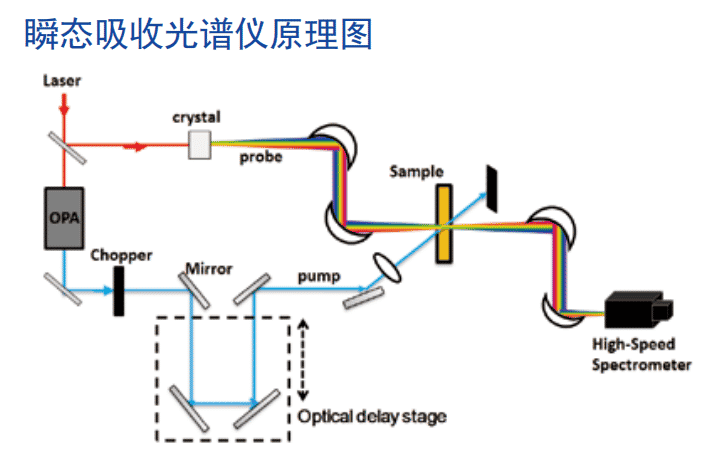Ultrafast fluorescence upconversion spectroscopy system
Chemical biology macromolecular structure, function and reaction kinetics studies* Ultrafast
Ultrafast spectroscopy is often applied to study the excited state processes of matter. Most physical effects occurring in general molecular atoms, such as the motion of nuclei and the twisting of chemical bonds, occur in the femtosecond to picosecond time range, charge separation and transfer, energy transfer, etc. occur in the femtosecond to nanosecond range, while the fluorescence lifetimes of luminescent materials are generally in the nanosecond order. In addition, light excitation can produce a wealth of transient products, such as excited state molecules, neutral radicals, positive or negative ionic radicals, etc., and steady-state test methods can only reflect the whole process of an integral effect, but can not reflect how the process is changing over time, so time resolution becomes an important parameter for a deeper understanding of the nature of the molecule itself. There are two main types of ultrafast spectroscopy systems in common use today: femtosecond time-resolved fluorescence systems and femtosecond pump-probe systems.
(1) Femtosecond time-resolved fluorescence (fluorescence upconversion) system.
It can be used to probe the process of luminescent state fluorescence decay with time, and can probe time-resolved fluorescence dynamics on the sub-femtosecond to nanosecond scale, depending on the laser pulse width and the length and accuracy of the delay line. The general time resolution of this system can reach tens to hundreds of femtoseconds, and its technical principle is shown in Figure 1.


The ultrafast fluorescence upconversion spectroscopy system is a detection system for transient fluorescence spectroscopy and dynamics with femtosecond time-resolved scales constructed in combination with a femtosecond laser light source. First, the femtosecond laser source is split into two laser beams, one beam is used to excite the sample, and the generated fluorescence is collected and converged into a nonlinear crystal to generate a sum frequency signal with the second femtosecond laser (gated pulse laser). The delay time between the two femtosecond laser beams is controlled by the optical delay line, and the sum frequency signal at different delay times reflects the fluorescence intensity at that moment, thus realizing the acquisition of fluorescence decay signal at the fs scale. Its common experimental optical path is shown in Figure 2.
.png)

The fluorescence upconversion technique is ultimately the most competitive technique in terms of time resolution, measurement sensitivity and accuracy. The technique has been used to study the ultraviolet, visible and near-infrared spectral regions and has been used to study many different phenomena such as solvation kinetics, intramolecular coherence vibrations, ultrafast photoisomerization reaction kinetics, charge transfer reactions, fluorescence properties of DNA nucleosides and nucleotides , solvation reactions at multiple sites in globular proteins, and water dynamics in biological recognition, condensed matter.
(2) femtosecond pump-probe (pump-probe) system, also commonly known as femtosecond transient absorption (transient absorption) technology, can be detected through the absorption spectrum of non-luminescent sample excited state rich information, common time-resolved transient absorption experimental system as shown in Figure 3.
.png)

One of the beams is used as pump light to excite the sample, and a certain percentage of the sample is excited to a high electronically excited state, which is typically 0.1% to a few tens of percent in different experiments. After a certain delay time t, a weaker probe light (which can avoid multiphoton effects) is passed through the region where the sample is excited, and the difference ΔT in the transmission spectrum between the presence and absence conditions (pump/un-pump) of the pump light is calculated, and by varying the delay time between the pump light and the probe light, ΔT can be obtained as a function of time and wavelength. In this way, the process of particle number distribution on different energy states as a function of time can be obtained.
Basic principles of transient absorption spectroscopy
Pump-probe transient absorption spectroscopy is based on the difference (ΔA) between the ground state absorption and the excited state absorption of a material sample after excitation (pump), and uses time-resolved monitoring (probe) of the ΔA(t) at different times after excitation of the material. ΔA(t) at different moments after excitation of the material

Since the same electron orbital can only accommodate two electrons with opposite spin directions, the absorption value at the same leap energy level after the sample excitation (the orbital has been filled with one electron) then becomes smaller, A' < A, and the transient signal ΔA < 0 (bleaching signal).
At the same time, the excited electrons or holes generated by the excitation of the material can leap to the electron orbitals at higher energy levels by absorption detection of light (probe), and the resulting transient signal is ΔA>0 (photoinduced absorption). Transient absorption spectroscopy obtains information on the dynamics of the photogenerated charge of the material by detecting ΔA at different moments after the excitation of the sample. In complex composite systems (e.g. semiconductor-semiconductor; semiconductor-organic/inorganic molecule; molecule-molecule), transient absorption spectroscopy can be used to detect the kinetic processes such as photogenerated charge relaxation and leap within the material, excitation too lifetime and photogenerated charge transfer between different materials, interface charge separation, energy transfer, etc. It is a powerful tool to study the motion of photogenerated charge.
Chemical biology macromolecular structure, function and reaction kinetics studies* Ultrafast
Chalcogenide carrier dynamics analysis* Laser scanning fluorescence lifetime (intensity)
Time-Tech Spectra Micro-area Reflection|Fluoroscopy|
Time-tech spectra ultimate cost performance ultra-fast